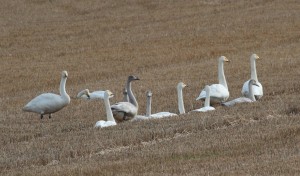 This is a good time of the year to drive up to the east coast from Inverness to Tarbat Ness as there is a chance of seeing two of the Highland’s iconic birds. One is a bird of prey, the red kite, that at one time was confined to a corner of Wales as a breeding bird. The other is the largest of our migrants, the whooper swan, and they fly down from the north with some spending their winters with us.
This is a good time of the year to drive up to the east coast from Inverness to Tarbat Ness as there is a chance of seeing two of the Highland’s iconic birds. One is a bird of prey, the red kite, that at one time was confined to a corner of Wales as a breeding bird. The other is the largest of our migrants, the whooper swan, and they fly down from the north with some spending their winters with us.
Young red kites were first released, as part of their re-introduction programme, between 1989 and 1993 on the Black Isle. 93 kites of Swedish origin were released and for many years this was one of the best places to see them. Even driving on the main roads there was always a good chance of seeing half a dozen birds. People went to see the feeding site at Tollie near Dingwall to see the gathering of kites which was a spectacular sight that introduced many people to these birds of prey. Then in March 2014 disaster struck as dead kites were being found in the Black Isle area. A total of 16 poisoned or suspected red kites and 6 buzzards were found. The sobering thought is that these were the birds that were found and there could have been many more just not located or eaten by predators. It is one of the biggest scandals in the Highlands that the culprits have never been found to this day. On my trip to Tarbat Ness last weekend I was lucky to see two red kites on the Black Isle.
I found the whooper swans in a field close to the famous red and white banded Tarbat Ness lighthouse. This is a field I have found whooper swans in before either resting up prior to their migration back north to Iceland or having just arrived and resting. So what can we make from the photograph that shows 13 birds from the flock, some call them a herd or bevy, of 26 in the field? To start with there are four juvenile birds there, in other words birds that would have been hatched this year in their northern breeding grounds in Iceland. These young birds have a grey plumage that contrasts with the pure white of the adults next to them and they lack the striking yellow of the beak. From the way the birds are grouped it looks as though there are three juveniles from one brood and single one from another. The adults will lay three to five eggs so the three may be from one clutch whilst the single one suggests only one juvenile bird survived from a clutch to get this far. The other adults could have had failed clutches for some reason or may not be ready to breed. They do not breed until they are 4 to 5 years old.
Judging by the way the birds are resting this flock may well have flown in from Iceland in the previous 24 hours and they could be tired after a non stop flight from Iceland. Some may well stay in the Highlands for the winter with a build up of large flocks in such places as Udale Bay on the Black Isle. A small number of whooper swans are ringed, either with neck rings or leg rings and these are large enough to be read with binoculars of telescopes. Several year ago I saw a neck ring on a swan in the same field and read the inscription. It showed that the swan had been caught when it was flightless in Iceland. It was spending its third winter in the Highlands but each year had flown to Ireland for the middle of the winter.
Tags: highland birds
